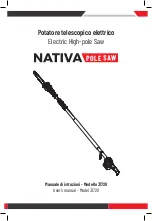
9
GROUNDING INSTRUCTIONS
Grounding of the
390
electric saw is necessary while in use
to protect the operator from electric shock or electrocution.
The saw is equipped with an approved three-conductor cord
and a three-prong grounding type plug to fit proper grounding
type receptacle. Do not remove the grounding prong from the
three-prong plug. The green or green and yellow conductor in
the cord is the grounding wire. The green wire in the cord must
be the only wire connected to the saw’s grounding system and
must never be attached to an electrically “live” terminal. The
saw must be plugged into an appropriate outlet that is prop-
erly installed and grounded in accordance with all codes and
ordinances.
WARNING
Do not remove or modify the plug installed on the
saw. Check with a qualified electrician if you are in
doubt if the outlet is properly grounded. Do not use
the saw if the cord or plug is damaged.
EXTENSION CORDS
GENERATORS
The
390
electric saw requires three wire extension cords only.
The cord should have the required three wire receptacle to ac-
cept the saw plug and have a three-prong grounding type plug.
As the distance from the supply outlet increases, a heavier
gauge extension cord must be used. Using extension cords
with too small a gauge of wire causes a serious drop in voltage
resulting in loss of power and possible saw damage. Refer to
the table shown to determine the required wire gauge. The
smaller the gauge number of the wire, the greater the capacity
of the cord. For example, a 14 gauge cord can carry a higher
amp load than a 16 gauge cord.
The mininum generator required to power the
390
electric saw
is 2800 watts continous with a 120 volt and 20 amp outlet pro-
ducing 60 hertz single phase power. Generators vary widely
so contact your generator distributor or manufacturer for their
recommendation.
RECOMMENDED MINIMUM WIRE GAUGE FOR
EXTENSION CORDS
Volts
Amps
Cord Length in Feet (Meter)
120V
13A
25(7.62)
50(15.2)
100(30.5)
150(45.7)
Minimum Gauge 16AWG
12AWG
10AWG
8AWG
MAINTENANCE
Guards
Check all guards for damage and proper function daily espe-
cially the blade guard. The blade guard should be secure to
the saw and not damaged.
Diamond blade
Inspect diamond blades daily for damage, cracks, secure fit
to the arbor, loss of segments, warping or overheating.
If any
blade shows any of these problems, discard the blade and
never use
.
Saw controls
Inspect all controls for proper function daily.
Check the ON/
OFF switch for proper operation
.
Skid plate
Inspect the skid plate daily for damage, excessive wear in the
blade slot, burrs on the concrete surface side, twisting, and
any movement when installed on the saw. Replace the skid
plate with each new diamond blade. Never re-use skid plates
or spalling and ravelling may result. Periodically, check the
skid plate for alignment with the blade. Insure that the blade
does not contact the skid plate and adjust if necessary.
MAINTENANCE SCHEDULE
Check guarding, diamond blade,
Daily
skid plate, and controls.
Clean blade housing assembly and saw.
Daily
Clean dust and debris from ventilation openings.
Daily
Cleaning
Clean the blade guard and bottom plate of any excess con-
crete build up after each use. Keep the handle clean and dry.
Keep all openings and slot on the saw clean and open so air
flows freely through the motor compartment to insure proper
cooling. Use compressed air and blow out the back side of the
motor where the air intake slots are located. Rotate the arbor
shaft by hand while cleaning the motor.
WARNING
Do not modify the saw! Use only Husqvarna Construc-
tion Products replacement parts. Use of unauthorized
parts may create a danger or damage the engine.
Saw pivot
The saw box should be free to pivot without binding on con-
crete deposits. Clean and/or replace bearings as necessary.
Wheels
Wheels should be wiped clean of sealers and concrete depos-
its. Inspect wheels for damage. Insure wheels roll freely.
Plastic case
Keep plastic case clean as loose material can lodge in motor
during transportation.
CAUTION
Certain cleaning agents and solvents damage parts.
Some of these are gasoline, carbon tetracholide, chlo-
rinated cleaning solvents, ammonia and household de-
tergents that contain ammonia. Avoiding use of these
and similar types of cleaning agents minizes the prob-
ability of damage.

































